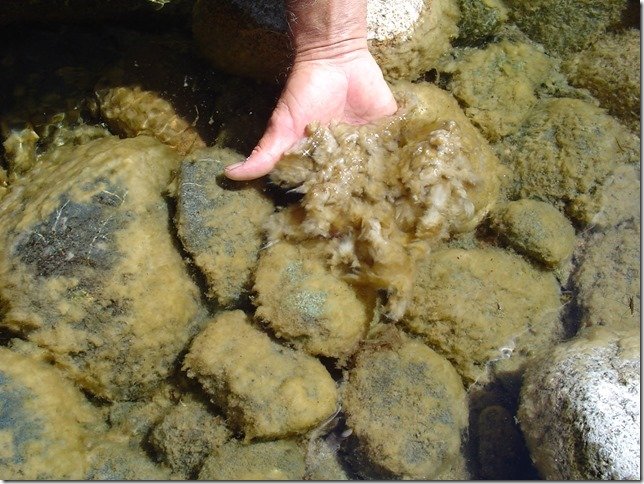Algae in Drinking Water
Could Algae Toxins in Drinking Water Cause Health Problems?
By Trevor Wicks
I was exploring along the Englishman River the other day when I noticed a greenish tinge to the water.
I took a photo of it immediately below the current drinking-water intake at Turner Road in Parksville.
Could be it be algae?
There is certainly ‘rock snot’ algae upstream of the intake in the Englishman. A photo of ‘rock snot’ algae in the Englishman River, below, taken some years ago.
High water temperature and high nutrient levels in surface water can create toxic algae in the drinking water. Some water-treatment processes actually cause the release of toxins from algae. It will be important to determine if the proposed new treatment plant will remove these toxins from the water.
Here are some sources of information on the subject.
From http://www.fwr.org/drnkwatr/algaltox.htm
Some species of cyanobacteria produce toxins within their cell structure. These toxins can be released when the algae die and decay. Toxin release can also occur during the growth phase of young algae. The implications of toxic algal blooms are significant and likely to become more so if global warming results in reduced flow in rivers with correspondingly less dilution for effluents and agricultural run-off.
From https://www.who.int/water_sanitation_health/diseases-risks/diseases/cyanobacteria/en/
Cyanobacteria or blue-green algae occur worldwide especially in calm, nutrient-rich waters. Some species of cyanobacteria produce toxins that affect animals and humans. People may be exposed to cyanobacterial toxins by drinking or bathing in contaminated water. The most frequent and serious health effects are caused by drinking water containing the toxins (cyanobacteria), or by ingestion during recreational water contact.
From https://www.epa.gov/sites/production/files/2014-08/documents/cyanobacteria_factsheet.pdf
Health effects caused by cyanotoxins The cyanotoxins include neurotoxins (affect the nervous system), hepatotoxins (affect the liver), and dermatoxins (affect the skin). The presence of high levels of cyanotoxins in recreational water and drinking water may cause a wide range of symptoms in humans, including fever, headaches, muscle and joint pain, blisters, stomach cramps, diarrhea, vomiting, mouth ulcers, and allergic reactions. Such effects can occur within minutes to days after exposure. In severe cases, seizures, liver failure, respiratory arrest, and (rarely) death may occur. There is evidence that long-term exposure to microcystins and cylindrospermopsin may promote the growth of tumors and may cause cancer.


